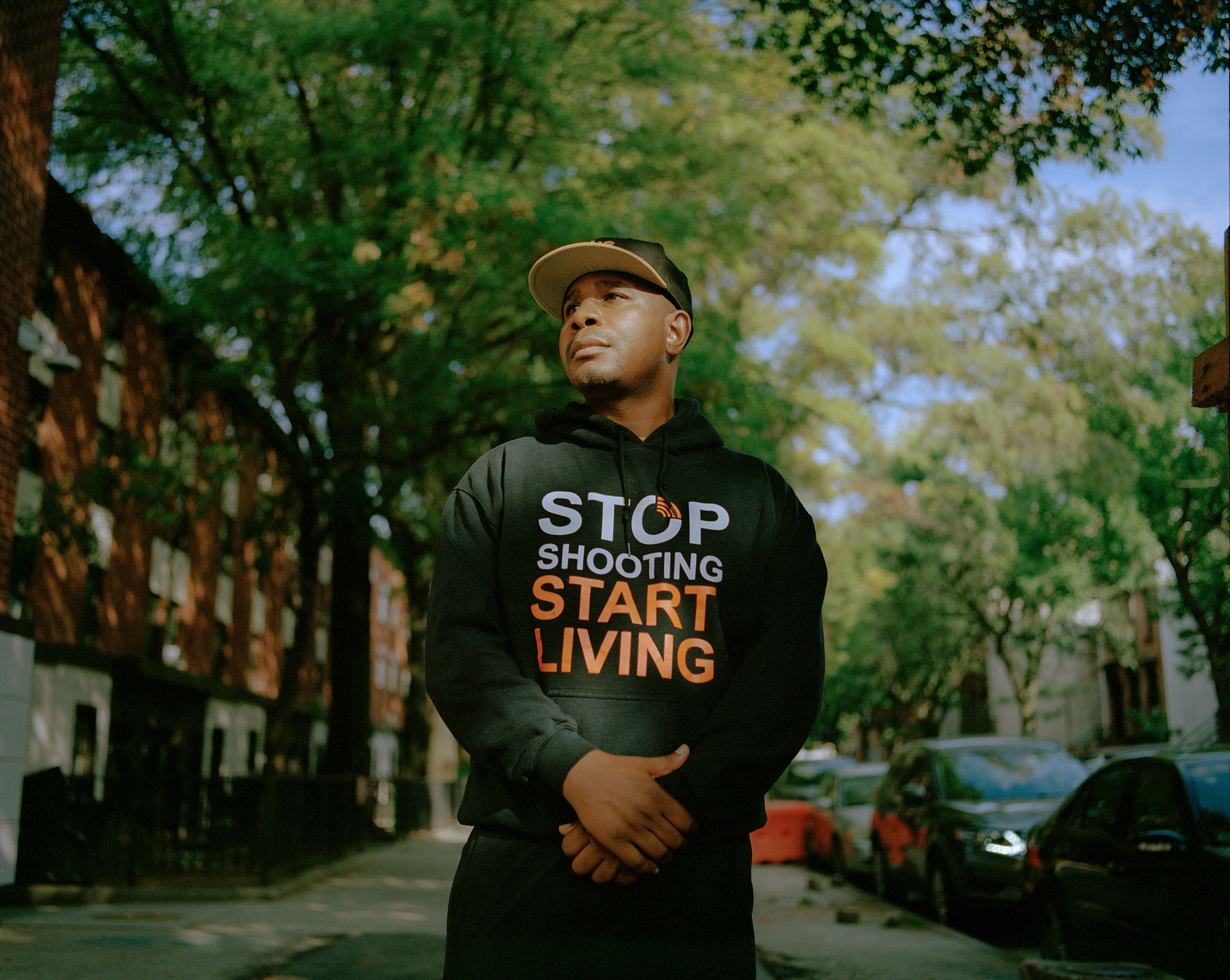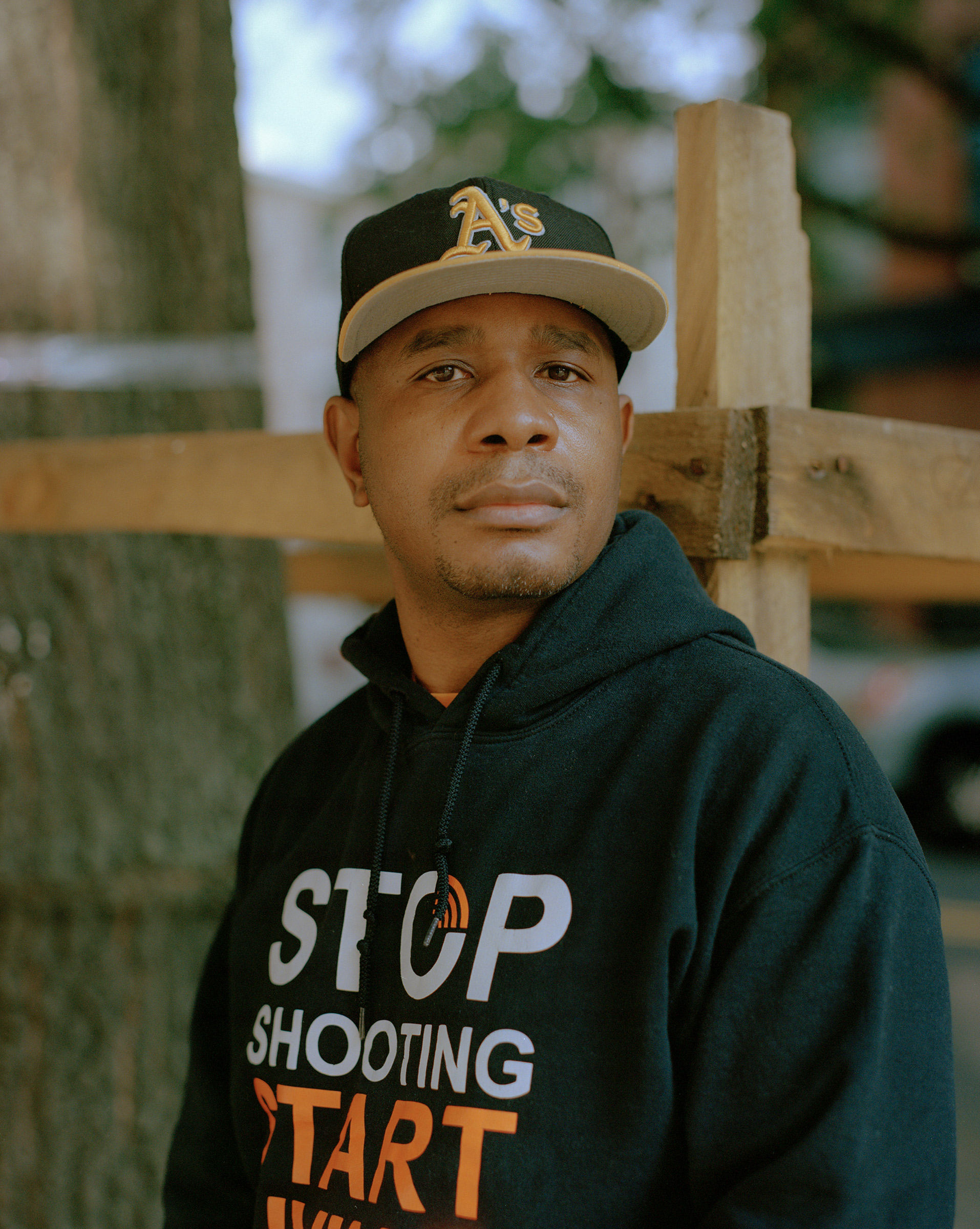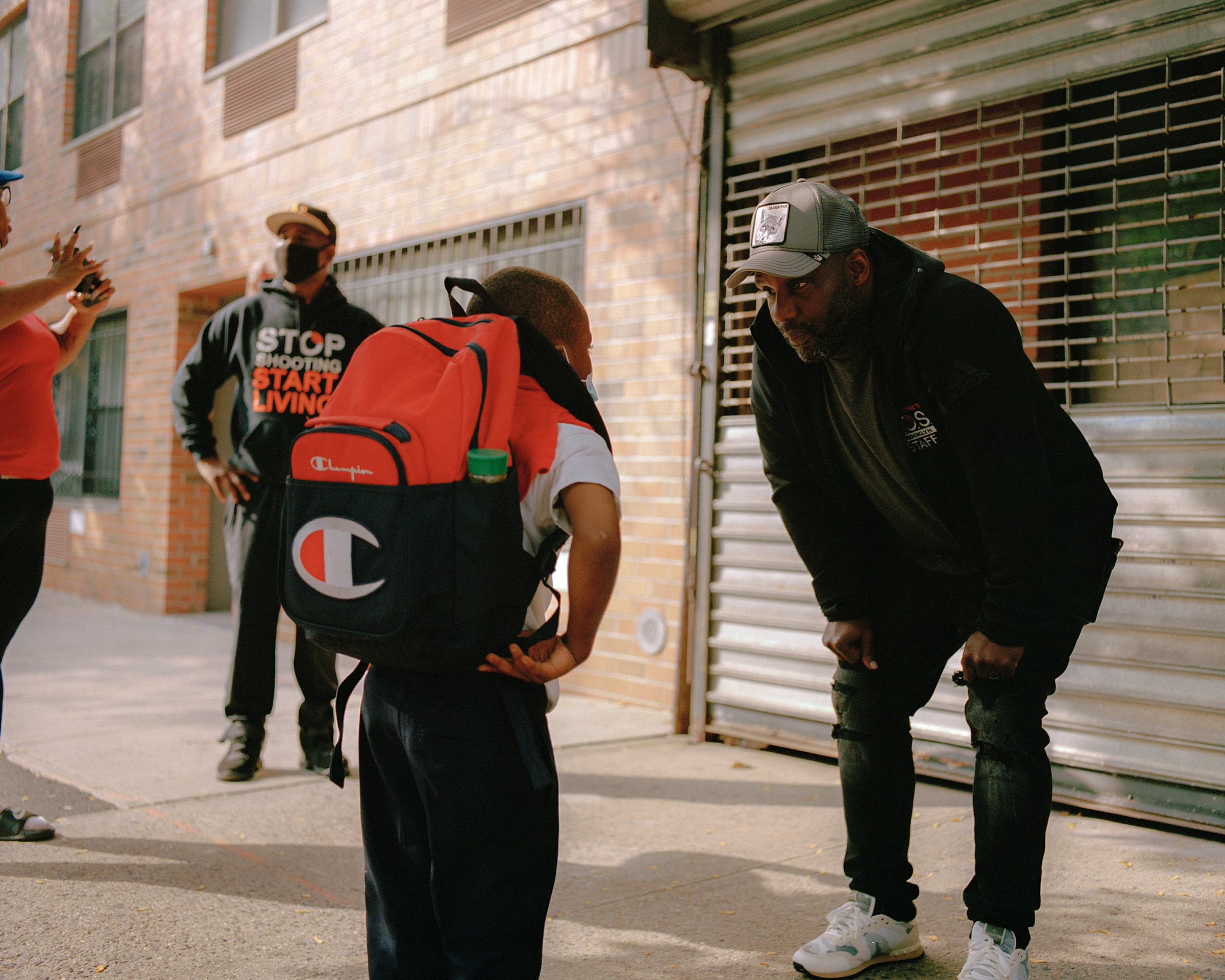
Just off a stretch of Eastern Parkway, the highway-like street that goes through many of Brooklyn, New York’s most disenfranchised neighborhoods, is a small office in Crown Heights.
What fills this small space is vital to the community. It’s the Crown Heights location for Save Our Streets (SOS), an activist group dedicated to combating gun violence in the borough. Inside there are desks, chairs and cubicles; a small indoor basketball hoop and a punching bag. There are posters on the walls, with portraits of Martin Luther King Jr. and John Lewis. One reads “Don’t shoot, I want to grow up.” Another says “stop shooting, start living.”

In a back room, a team of young Black men and women are preparing for a community event. They are volunteers, outreach workers and practitioners of what’s known as violence interruption—the work of credible neighborhood messengers attempting to quell violence within inner-city communities. Among them is Rahson Johnson, 46, the organization’s associate director of community safety. Johnson is stoic, measured and methodical as he prepares to lead the group outside for an event.
He guides some of the other members like it’s second nature, reminding them of the supplies to bring: a speaker, pamphlets, shirts, water, snacks and masks for COVID-19 safety.
They are heading to the scene of a shooting—a street corner where, on Aug. 1, a young man was killed. (The NYPD has since made an arrest in the case.) As they walk, SOS workers also try to hand out their cards to people on the street. In the middle of a residential area, they set up a speaker so the entire block can hear what they have to say: They’re there to denounce gun violence, and to remind the community that they’re available to offer any kind of help or support. And they’re coming from a real position of expertise—most of the interrupters, if not all, were previously involved in street crimes and gun violence themselves.
Read more: There’s a Proven Way to Reduce Gun Violence in America’s Cities. We Just Need to Fund It
“[A lot of us] were people who, at one point, we’re the ones pulling the trigger,” Johnson tells TIME. Johnson grew up in the Bedford-Stuyvesant (otherwise known as Bed-Stuy) neighborhood and at a young age got caught up in criminal behavior. He says he was a “stick-up” kid, and got involved in robberies. At the age of 16, he was arrested for armed robbery and spent 23 years in prison.
During their event to condemn the shooting, one by one, the interrupters take the microphone. “Our community feels like every time there’s a conflict it needs to end in gun violence,” one says. “We are failing—we have to do better.”

Since the onset of the COVID-19 pandemic, a surge in gun violence has hit the U.S. hard. New York City has grappled as badly as any other city, if not worse. More than 1,400 people have been shot in NYC this year with 360 deaths as of Oct. 12. These numbers are on pace to match or surpass the total incidents and fatalities accrued in 2020. In the two areas where SOS operates—Crown Heights and Bed-Stuy—there have been more than 75 shootings incidents in 2021, with more than 90 victims and 18 deaths as of Oct. 12. (While both neighborhoods are on track to have lower shooting victim numbers and incidents than in 2020, this is still a devastating toll.)
SOS’s work is based upon the a model espoused by Cure Violence, a national organization that addresses gun violence as if it were a disease and works to ‘treat’ it. And as more attention is paid to these initiatives, there is increasing evidence that they are effective in reducing shootings.
Former New York Gov. Andrew Cuomo declared a state of emergency related to gun violence on Aug. 2. Cuomo had planned to use $139 million to address the rise in gun violence; after his resignation, Gov. Kathy Hochul announced $23.7 million in grant awards to “end the gun violence epidemic.” (Though Hochul’s office did not immediately respond to TIME’s request for comment, it’s understood that her figure replace the monies Cuomo was calling for.) In September, Eric Adams, the Democratic Mayoral nominee, and Senate Majority Leader Chuck Schumer called on Congress to invest $5 billion in community funding to combat gun violence in New York City, which includes the work of violence interrupters.
Their work is viewed by many as a possible alternative to policing; in some situations, they can be in conflict with more traditional police department methods. Some within the communities directly impacted by gun violence question which ‘side’ is more effective at addressing gun crimes, framing it as an either-or situation—though in a more ideal world, these two groups would operate together more seamlessly.
At that August event, after spreading their message via loudspeaker, the SOS workers move to the corner where the shooting happened. More onlookers and community members are present. While many of them express their gratitude for this work, others are less enthused. One man in particular debates with one of the violence interrupters, saying those involved in shootings are “too far gone” and “need to be locked up.” The interrupter respectfully disagrees.
As all of this is going on, a cop car is parked across the street, with a couple of officers sitting inside.
The differing roles of community members and community police
Though they operate in two different spheres, police and community groups like SOS play significant roles in addressing both gun violence and the wider socioeconomic issues that impact it.
In recent years, the New York City Police Department (NYPD) has tried to prioritize “community policing,” programs that involve beat police officers building personal relationships with the communities they serve. In 2015, the department introduced the Neighborhood Coordinating Officers (NCO) program, spearheaded by former Commissioner Bill Bratton, which featured more community-oriented policing strategies.
“There was a sense that our department needed to make this a priority. We felt the pressure both internally and externally,” a former NYPD bureau chief explains. “I thought it was something that we needed to do.”
According to the Mayor’s Management Report, an annual public account of the performances of all city agencies in the fiscal year, “the effectiveness of patrol officers as local crime fighters and local problem solvers has been enhanced by Neighborhood Policing.”

NCOs are assigned to “sectors” in a particular precinct; their job is to build trust and relationships with the community—”helping prioritize and adapt police operations to respond to community concerns,” as the Mayor’s Management Report puts it. That way, residents can, in theory, call or text an NCO directly when dealing with problems or reporting concerns. Since making the NCO program permanent, the NYPD has dedicated significant resources to it. A total of 51 precincts in the NYPD currently have NCO officers, usually around five to six officers per precinct. In both Bed-Stuy and Crown Heights, many residents and community leaders say they appreciate their presence.
“It was about connecting the officers to the community,” Henry Butler, the district manager for Community Board 3, which includes Bed-Stuy, says of the NCO program. “It’s so the community can see a regular face. When they’re there, the officers do a good job.”
Read more: America’s Policing System Is Broken. It’s Time to Radically Rethink Public Safety
But while the sentiment behind the formation of the NCO program in New York appears sincere, experts and observers say that’s not always the case when police departments enact these kinds of initiatives. “I’ve seen good examples of [community policing], but sometimes it feels like [authorities] are just going through the motions,” Paul Carrillo, the community violence initiative director at the Giffords Law Center, says. “Is it really embedded in the mission and the goals of the department?
“[The police] don’t actually care. It’s all for show,” Ellera Lewis, a lifelong Bed-Stuy resident, told TIME in August.
Because of the way these systems are structured, SOS members and the NCOs operate in the same neighborhoods and address some of the same concerns. Separately. SOS members say that they stay out of officers’ way—and that, for the most part, the police show them that same courtesy.
But there were some conflicts within their interactions in the summer of 2020 amid fallout from George Floyd’s murder, which was a turning point for both of these groups. According to SOS members, residents and community leaders who spoke with TIME, some officers were “upset” by calls to defund the police—and with the praise groups like SOS were getting. At the height of the protests, some SOS staff members say that they were asked by NYPD officials to “stand with the police.”(The NYPD did not respond to questions from TIME on this matter.)

“There’s no way in the world we were going out there to stand with [the police],” Simon says. “We denounce all gun violence, including police gun violence.” SOS members make it clear that they would never cooperate with the police in solving crimes.
At the same time, in the eyes of community members, the police took a step back from their responsibilities. Residents say they saw fewer officers—and fewer NCOs specifically—on the streets. Though this can’t be the sole reason for the sharp increase in gun violence that summer, it was a loud and clear statement to some people.
In the year since SOS members tell TIME they believe the dynamic between them and the police has more or less gone back to normal. But even normal can be tense and it’s a baseline that both groups are tasked with working to better.
Finding middle ground
There’s no denying the work SOS members do is dangerous, and none of them are armed.
SOS’s Rahson Johnson recalls a specific incident back in 2019 when two young men—who Johnson says had been close friends “to the point where they referred to each other as brothers”—were in conflict over a girl one of them was dating. According to Johnson, the situation could have become dangerous. To mediate, he and another worker brought the two into the SOS office to discuss their differences. At first, the discussion was tense, Johnson recalls. The two men were yelling and trying to offend one another. Johnson says he told them both to take a pause and to focus on how their conflict had made them feel like individuals. He reminded them of how close they were. Eventually, they were able to come to an understanding and resolve the issue.
This speaks to the breadth of issues violence interrupters can work to address—their work is by no means limited to crimes. The goal for the SOS workers is to resolve every conflict they encounter, but that’s not their reality.
“You have people in this community whose mindset is strictly survival—and for them, the only way to survive is with a [gun] in their hand,” Johnson says. “It can be very challenging to change that.”
“It may be out of [our] control; the person is like ‘man, my mind is made up, this is what I’m going to do,’” adds Joshua Simon, a violence interrupter with the Bed-Stuy SOS office. So they may try and reach the person again the next day or the day after that. “Hopefully the message will resonate with them,” Simon says.
Read more: What Counts as a Mass Shooting? Why So Much of America’s Gun Violence Gets Overlooked
In some instances, when the interrupters can see a situation getting out of control and know that the police will soon be involved, they’ll ask if they can try and resolve it first. There have also been times, according to some SOS members, when NCOs have asked for help dealing with individuals.
“[The police] will say ‘we don’t want to have to lock them up. Can you guys talk to them,’” Lawrence Brown, an SOS member with the Bed-Stuy office says. “The answer is not always imprisonment, and so we appreciate when they do that.”
However, that’s as far as it’ll go. “We can only de-escalate a situation before it happens,” Simon says. “We’re not looking to make arrests—that’s the police job.”

In the four-block radius that the Bed-Stuy interrupters operate on, there has not been a shooting incident for 285 days as of Oct. 12. For the Crown Heights area, it’s been 78 days as of Oct. 12. The NYPD declined to allow TIME to interview NCOs—who are tasked with operating in a larger area—on the record for this story and did not provide TIME with comparable statistics or tracking related to officers’ work.
Butler appreciates the NCOs and believes they do a good job, but says the officers’ hands are tied: “The problem with the program is that the NCOs are only there for six to nine months,” Butler says. “By the time they build up that relationship with the community, they move on. It sort of defeats the actual purpose of the program.”
And what’s also hard to parse out is a preference from community members in these neighborhoods for one model or the other. Some activists have argued that it shouldn’t have to be an either/or situation. “Police do things that [violence interrupters] can’t. Violence interrupters have a connection to the community that the police don’t have,” Carrillo says. “There needs to be reform in some cases more than others but the interruption side of it and the police side of it are both important.”
Reflecting on the past 18 months, Johnson says he sees the shift in the discussion around gun violence: more people talking about it, more people working to find solutions. His hope is that the conversation goes beyond just the physical trauma that comes with the violence.
“The idea is safety. I don’t think that we have really honed in on the emotional safety and trauma that’s sustained over a period of time,” Johnson says. “For me, the question is how do we show up the next day, the next week with resources to help heal the community?”
More Must-Reads from TIME
- Cybersecurity Experts Are Sounding the Alarm on DOGE
- Meet the 2025 Women of the Year
- The Harsh Truth About Disability Inclusion
- Why Do More Young Adults Have Cancer?
- Colman Domingo Leads With Radical Love
- How to Get Better at Doing Things Alone
- Michelle Zauner Stares Down the Darkness
Write to Josiah Bates at josiah.bates@time.com